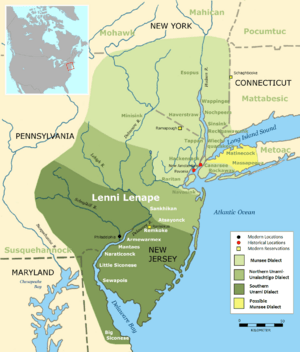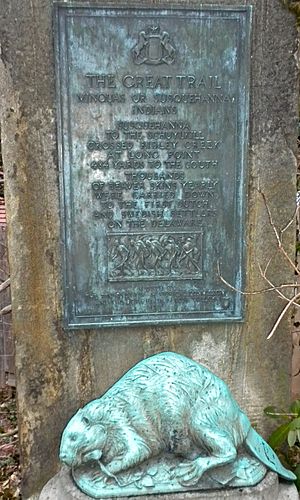Great Minquas Path facts for kids
The Great Minquas Path, also known as The Great Trail, was a very important trade route in the 1600s. It ran about 80 miles (130 km) through southeastern Pennsylvania. This path connected the Susquehanna River (near Conestoga) to the Schuylkill River, across from what is now Philadelphia.
The path was mainly used for trading animal furs with the Minquas people. The Minquas were also known as the Susquehannock. Different European groups, like the Dutch, Swedes, and English, all wanted to control this valuable trade route. They sometimes fought over it.
Dutch Influence on the Path
The Dutch were the first Europeans to start trading furs along this path. This began in the 1620s. They called the trail "Beversreede," which means "Beaver Road." This name shows how important beaver furs were for trade.
Around 1633, the Dutch built Fort Beversreede. This fort was at the eastern end of the trail. It was located where the Schuylkill River meets the Delaware River. A map from 1655 shows the fort on Providence Island. This island is on the west side of the Schuylkill River.
In 1634, the Susquehannock people used the Great Minquas Path. They traveled along it to conquer the Lenni-Lenape people. The Lenni-Lenape were also called the Delaware people. The word "Minquas" meant "treacherous" to the Lenni-Lenape. This was because the Susquehannock were their traditional enemies. The Dutch and later the Swedes adopted this name.
Swedish Attempts to Control Trade
The Swedish colony, called New Sweden, was founded in 1638. It was about 20 miles (32.5 km) south of Fort Beversreede. Today, this area is Wilmington, Delaware.
In 1644, Governor Johan Björnsson Printz of New Sweden built Fort Nya Vasa. This fort was placed where the Great Minquas Path crossed Cobbs Creek. The Swedes hoped to take some of the Native American trade away from the Dutch. However, this attempt was not very successful.
Governor Printz then tried to gain control at Fort Beversreede itself. In 1648, the Swedes built a blockhouse right in front of the Dutch fort. This made the Dutch fort useless for defense. Because of this, the Dutch left their fort in 1651.
However, the Dutch returned a few years later. In 1655, under Peter Stuyvesant, the Dutch conquered "New Sweden." They renamed the colony "New Netherlands."
English Takeover and Legacy
The English then conquered the Dutch in 1664. The small colony became part of a large land grant given to William Penn in 1681. The English called the Susquehannock people "Conestogas." This name came from their main settlement on the Susquehanna River.
The Conestogas faced many challenges. Many of them became sick from diseases like smallpox. They also had long conflicts with European settlers in the Chesapeake Bay area from 1642 to 1652. They also fought with the Iroquois people to the north from 1658 to 1662. Many Conestogas moved away or joined other tribes.
In December 1763, a group called the Paxton Boys attacked the remaining Conestogas. This event led to the tribe disappearing in Pennsylvania.
Today, Strasburg Road in Chester County and Lancaster County generally follows the old route of the Great Minquas Path. You can find Pennsylvania State historical markers along the trail. These markers are in Philadelphia, Delaware, Chester, and Lancaster Counties. They help people remember this important historical route.



